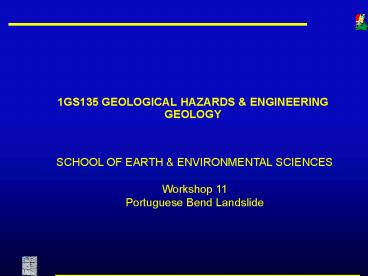1GS135 GEOLOGICAL HAZARDS PowerPoint PPT Presentation
1 / 17
Title: 1GS135 GEOLOGICAL HAZARDS
1
- 1GS135 GEOLOGICAL HAZARDS ENGINEERING GEOLOGY
SCHOOL OF EARTH ENVIRONMENTAL
SCIENCES Workshop 11 Portuguese Bend Landslide
2
Portuguese Bend Landslide
3
Portuguese Bend Landslide
4
Portuguese Bend Landslide
http//ublib.buffalo.edu/libraries/projects/cases/
abalone2.html
5
Geological Cross Section
6
Portuguese Bend Landslide
Below is a view of the ancient landslide the
very recent Portuguese Bend landslide. A fault
scarp can be seen above the dirt road cutting
through the centre of the slide. This scarp
marks the eastern border of the recent landslide.
In the 50's many houses were built in the area.
All were destroyed by the motion of the landslide.
http//siogeoscience.ucsd.edu/undergrad/portuguese
_bend_pics.html
7
Portuguese Bend landslide. A scarp created by
horizontal motion down drop faulting along the
eastern border as the landslide has moved five to
six hundred feet towards the south (right hand
side of the picture).
http//siogeoscience.ucsd.edu/undergrad/portuguese
_bend_pics.html
8
Workshop
9
Workshop
1. What is the essence of the Associated
Press article? 2. What is the
scientific basis for the homeowners'
suit? 3. What information is
required to evaluate the scientific basis of this
lawsuit?
10
Workshop
1. What natural conditions in this area are
conducive to landslides? 2. What
specific type of mass movement is likely to occur
in this geologic setting? 3. Is it
possible that the 1956 Portuguese Bend Landslide
was triggered entirely by natural
causes? 4. What human action(s)
could have contributed or triggered this
landslide?
11
Workshop
1. What information would be needed to
evaluate the effect of septic system discharge
and lawn irrigation on groundwater
levels? 2. How would the
construction of Crenshaw Boulevard differ from
the earlier construction of houses in terms of
its ability to trigger a landslide? 3.
What do the success of various corrective
actions taken here suggest was (were) the
cause(s) of the landslide?
12
Landslide Development
The land above this plane slid towards the ocean.
The actual cause of this weakness that occurred
37,000 years ago is not well understood. Total
displacement is also not known. This movement,
called the "Ancient Landslide," is no longer
active.
The Portuguese Landslide is a translational
slide. The Portuguese Bend Landslide actually
occurred in two pulses. The first began about
37,000 years ago. At this time, a cross section
of Palos Verdes looked something like the diagram
above.
Notice that bedding is slightly steeper then the
profile of the land. A plane of weakness
developed. Notice that the plane of weakness is
parallel to bedding.
After this movement ceased, a new, more shallow
plane of weakness formed. An ancient volcanic
eruption produced the geologic layer that
developed the recent plane of weakness. The thick
(50 ft) volcanic ash and subsequent thinner
layers altered to a clay called bentonite.
Bentonite absorbs much water and can lose its
cohesiveness, forming slip planes along which the
land can slide.
Here is how the landslide appears today
http//seis.natsci.csulb.edu/VIRTUAL_FIELD/Palos_V
erdes/pvportuguese.htm
13
Landslide Development
http//seis.natsci.csulb.edu/VIRTUAL_FIELD/Palos_V
erdes/pvportuguese.htm
14
Portuguese Bend Landslide
15
Abalone Cove. A photograph of the eastern side of
Altamira Canyon which runs up the center of the
landslide. The sedimentary features show that
portions of the Abalone Cove have moved as
coherent blocks maintaining its original bedding
features
http//siogeoscience.ucsd.edu/undergrad/portuguese
_bend_pics.html
16
Portuguese Bend Landslide
The still moving Portuguese bend landslide is
cracking apart the asphalt of Palos Verdes Drive.
The road has to be resurfaced on a yearly basis
to cover up the cracks created by the still
moving landslide.
http//siogeoscience.ucsd.edu/undergrad/portuguese
_bend_pics.html
17
Portuguese Bend Landslide
Basaltic dyke and hard sedimentary beds at
Inspiration Point at the western edge of
Portuguese Bend landslide. The dyke and the hard
sedimentary beds do not erode and the sediments
of the landslide pile up against them
http//siogeoscience.ucsd.edu/undergrad/portuguese
_bend_pics.html

